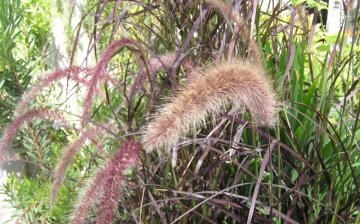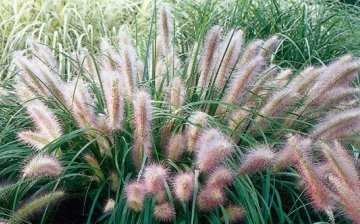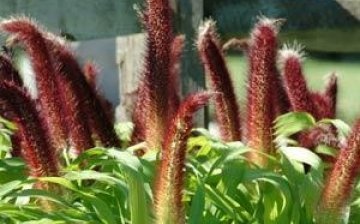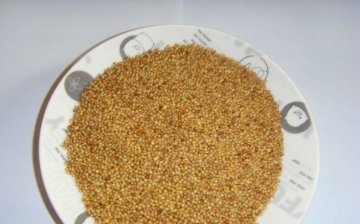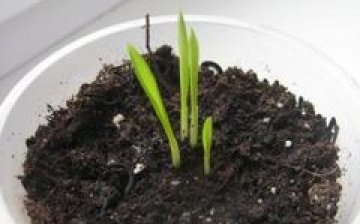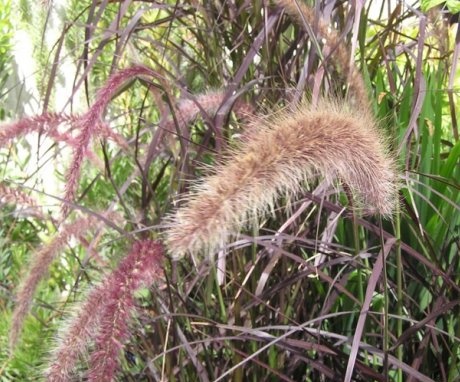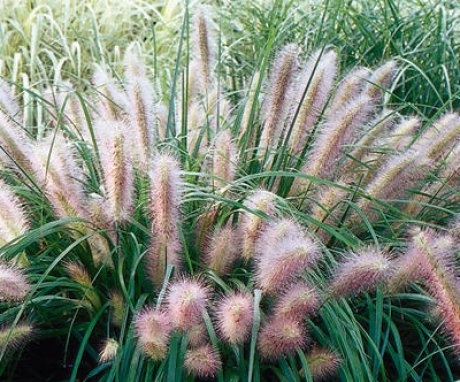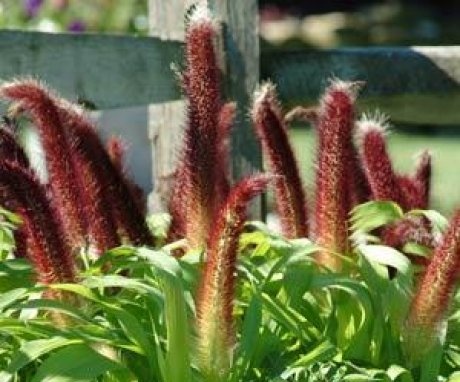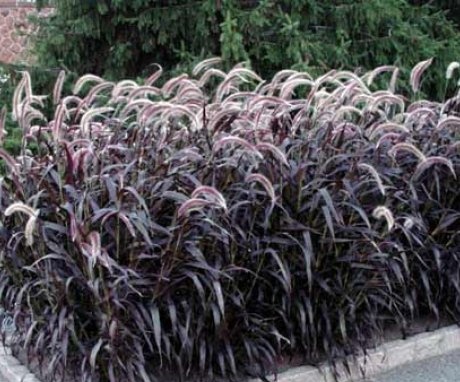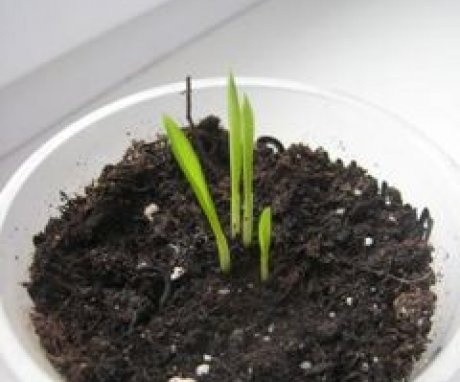Features of the pennisetum plant
The plant has two names: pennisetum and pinnacle. The perennial belongs to the Zlakovy family and came to us from Asia. Today, the pennisetum is cultivated all over the world, from America to Asia and Africa.
Content:
- Description of the plant
- Pennisetum types
- Features of pennisetum care
- Removing the aennisetum from seeds
- Reproduction and possible difficulties in growing
Description of the plant
The appearance of the plant completely coincides with its name, translated from Latin "pennisetum" means "feather and bristle". Spikelets of the plant are collected in whorl inflorescences, which, in turn, are completely covered with bristles, pinnate-hairy structure.
In nature, there is a huge number of pennisetum species, botanists number about 150, but only some of them are cultivated in our country, and those are not particularly popular. But many species can be found in large numbers in South America and African countries.
Plant characteristic:
- There are no hairs in the lower part of the branch, while the rest is rough or hairy.
- Spikelets have two flowers, one of them is more developed, it is also bisexual, the one that is less developed has only a stamen.
- The average length of each spikelet is 0.5 cm.
- Pennisetum is a tall plant, its maximum height is 1.5 m, but there are also low-growing varieties.
- The panicle length ranges from 3 to 30 cm.
- Inflorescences in the form of spike-shaped panicles can be both cylindrical and one-sided.
- Stems are erect, leaf blades are thin, sagging or linear in shape.
- The spikelets of the plant are quite long, sometimes they reach 15 cm.
- The plant has the greatest decorative value in the autumn period. At this time, the foliage becomes bright yellow, and the spikelets remain green, such a contrast is inherent in not so many plants in nature.
Pennisetum has adapted well to the climate of our country, although he loves hot countries, at the same time he is considered one of the frost-resistant representatives... Throughout the winter, the bush remains bright, only a harsh winter with strong winds and a lot of rainfall can damage the fragile stems.
The people can hear the name "fountain grass".
This is the name of the pennisetum because of its appearance, the plant bends well, and when the fluffy spikelets fall to the ground, they resemble the flowing streams of a fountain. A particularly beautiful sight appears in windy weather, when the spikelets sway and tremble. The plant does not carry nutritional or medicinal value, it is grown in gardens only for decorative purposes. Growing pennisetum is only suitable for painstaking and attentive gardeners, because every year this perennial needs abundant pruning, and the leaves can damage the skin of the hands.
Pennisetum types
In nature, pennisetum grows in the subtropics and tropics. Despite the abundance of species, foxtail pennsetum is most often grown at home.
Fox-tailed species.
- It was first discovered in Australia and East Asia.
- It is a perennial, which has long inflorescences from 40 to 100 cm long, the inflorescences have decorative value.
- They are fluffy, soft to the touch, and the shade ranges from purple to reddish brown.
- The leaves are narrow, linear, green in summer and yellow in autumn.
- The plant begins to bloom in late summer, the shrubs themselves are quite dense.
- Easily endure winter outdoors.
- Even in the middle lane, they are not afraid of the cold, if you make a shelter from spruce branches or leaves.
- Before wintering, the leaves must be cut off.
- A common phenomenon is when the pennisetum becomes smaller every year, and subsequently drops out. Therefore, from time to time it needs to be renewed, and in winter it is desirable to bring it into the house.
Pennisetum east.
- Prefers rocky slopes and rocks.
- Plant height ranges from 15 to 80 cm, in nature they form extensive turf.
- It settles well in the south of Russia, it is successfully grown in Ashgabat and Baku.
- The panicles are from 4 to 15 cm long, dense, pink or purple, the bristles are rough, hairy at the bottom.
Shaggy Pennisetum.
- It also grows on rocks, talus and rocky slopes, and occurs naturally in East Africa. They get along well in Baku, Ashgabat, Tashkent, it is recommended for cultivation in the south of Russia, although pennisetum has not yet been tested there.
- Plant height is about 40-50 cm, leaves are flat, panicles are golden, very dense.
- Spikelets are collected in several pieces with a large number of hairy setae.
Pennisetum is simple.
- He came to us from China, so it can be grown here, as the climate is similar.
- This species differs from all the others in its massiveness.
- The maximum plant height is 1.2 meters, the leaves are large, gray-green.
- It begins to bloom in early June and the flowers do not fall until September.
- Spikelets are thin and long, but not noticeable.
- The plant needs bright sun, it is picky about the soil.
- Can be grown in a curb, despite the fact that this species loves space.
- Withstands frosts down to minus 30.
Pennisetum is gray.
- It has large bronze-burgundy leaves, reaches a height of 2 m.
- The flowering period lasts from July to September.
Pennisetum bristly.
- Prefers talus and rocky slopes, climatic conditions should be similar to subtropical or tropical.
- Panicles reach a length of 35 cm, pink or purple in color, the structure is loose, the spikelets are collected in small groups.
- Dry plants are used in bouquets because of the high decorative effect of the panicles.
Features of pennisetum care
Pennisetum came to us from hot countries, therefore, when growing in a garden on our continent, it needs to be provided with similar conditions.
The plant loves warmth, the site should be in the open sun. Gardeners most often grow pennisetum in containers, and the plant sometimes goes from perennial to annual.
Growing tips:
- When grown outdoors, there will be no differences, you just have to take care of protection from drafts and winter frosts.
- The plant is not picky about the soil, both dry and moderately dry soils are suitable, but very dry or dense soils are not recommended.
- Ideal soil is moist, breathable, well-drained with humus content.
- Pennisetum should be given the most attention during the growing season.
- All weeds need to be pulled out and the soil is regularly loosened, with low rainfall, water and fertilize twice a month.
- Despite the fact that the plant does not tolerate drought, and excess moisture is contraindicated for it.
- To prevent moisture from accumulating, it is not necessary to plant pennisetum in the lowlands; it is better to do this near the walls of buildings that will protect from the wind.
- For the winter, the plant is better move indoors, since not all species can tolerate low temperatures.
- Pennisetum containers are placed in a well-lit place.
- If the plant remains to winter outdoors, then it is carefully covered with spruce branches, bark or peat.
Pennisetum gets along well with other plants and goes well decoratively.
Removing pennisetum from seeds
Not all gardeners risk growing pennisetum in their backyards.Many are sure that an exotic plant requires special conditions that are difficult to create in our climatic zone. However, this is a big misconception, special knowledge is not required to grow pennisetum, it is important to simply follow agricultural techniques.
For example, to achieve flowering this year, you need to plant seeds in February, and not at the end of spring.
Almost all cereals are difficult to tolerate transplants with bare roots, therefore, seedlings grown in cups will take root faster and develop better. This is best done in a large drawer, and in separate small cups or other containers.
Growing from seeds:
- When planting a seed, it is not sprinkled with soil, but pressed into the ground by a few millimeters.
- At home at room temperature, the seed will germinate in a week, but for some time it will need to be supplemented.
- In May, when the plant reaches 10-15 cm in height, it can be transplanted into open ground.
- It is not recommended to buy seedlings in containers, there is a risk that they will not take root well. Better to work hard and grow seedlings yourself from seeds.
Reproduction and possible difficulties in growing
Pennisetum is propagated by seeds and dividing the bushes.
The first method is suitable for annual representatives, the second for perennials. The bush can be divided once every five years; too small parts cannot be separated. If the plant is grown using seeds, but it will only start blooming the next year. Ready seedlings are first planted in boxes in April, and already in May they are moved to a permanent place on the site. Annual pennisetums are used to form hedges and arrays.
If the pennisetum is annual, then it is propagated at the end of spring:
- Seeds can be planted directly in open ground, or you can grow seedlings in a container indoors.
- Under favorable conditions, pennisetum can reproduce on its own. It is most advisable to plant them along buildings, fences and fences.
- Perennial representatives grow well in a container or tapeworm.
Many species and varieties of pennisetum are large, so they can be planted in the background of the garden.
The biggest challenge in growing is how to ensure the long life of the plant? Due to the peculiarities of our climate, the pennisetum behaves like an annual. To avoid this, you need to grow the cereal in containers or provide good shelter for the winter... It is worth noting that the pennisetum practically never gets sick, it is not afraid of any diseases and it is not susceptible to insects, fungi and other pests. At the end of autumn, the plant must be cut to the root, so it can survive the winter.
If we are talking about foxtail pennisetum, then it has high endurance, which is why it is recommended for cultivation in our country.
For the winter, you can not cut it, but only cover it with leaves or spruce branches. But even such a procedure will not be able to protect the plant from rapid aging, therefore, to stop degeneration, it needs to be divided from time to time. For residents of the southern regions, any other varieties of pennisetum are suitable.
More information about perennials can be found in the video.




